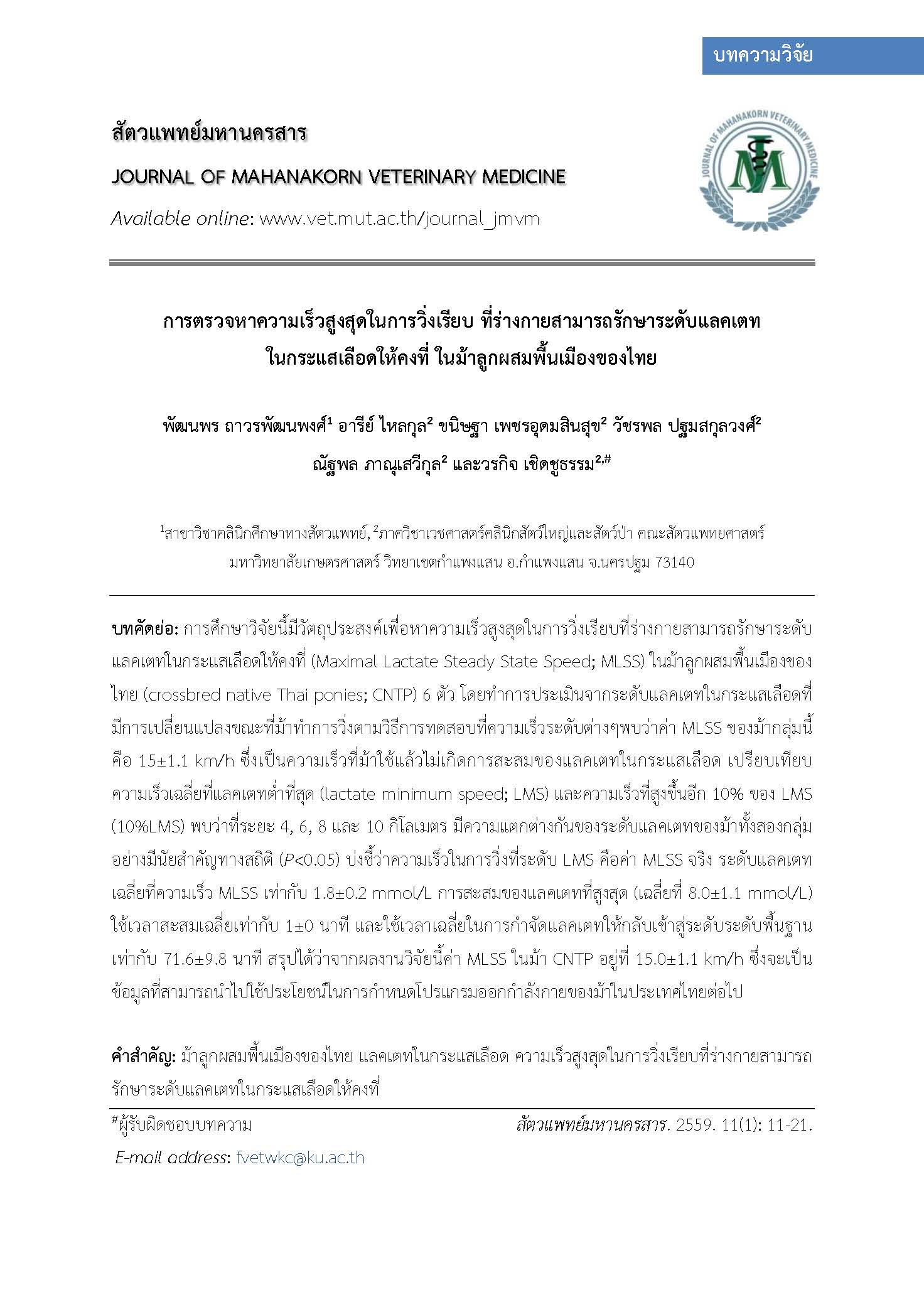Determination of the Maximal Lactate Steady State Speed of Trotting in Crossbred Native Thai Ponies
Main Article Content
Abstract
The purpose of this study aimed to determined maximal lactate steady state speed (MLSS) of the 6 crossbred native Thai ponies (CNTP). Blood lactate concentrations during different velocity of protocols were evaluated. The MLSS in CNTP was 15±1.1 km/h which did not accumulate of blood lactate. Compared mean lactate minimum speed (LMS) and comparison with 10% above LMS, found significant different lactate concentration (P<0.05) at 4, 6, 8 and 10 km. distance indicating that LMS was absolute MLSS (mean MLSS lactate was 1.8±0.2 mmol/L). The average peak blood lactate (LP) was 8.0±1.1 mmol/L. The mean of lactate peak time was 1±0 min. after the exercise test, and mean of the time to base lactate was 71.7±9.8 min. In conclusion, the MLSS of CNTP (15±1.1 km/h) was proposed from this study that would be beneficial for tailoring the exercise program of this type of equids in Thailand.
Article Details
References
Brooks, G.A. 1991. Current concepts in lactate exchange. Med. Sci. Sports. Exerc. 23 (8): 895–906.
Carroll, C.L. and Huntington P.J. 1988. Body condition scoring and weight estimation of horses. Equine Vet. J. 20(1): 41-45.
Castejón, F., Rubio, D., Tovar, P., Vinuesa, M. and Riber, C. 1994. A comparative study of aerobic capacity and fitness in three different horse breeds (Andalusian, Arabian and Anglo-Arabian). ZentralblVeterinarmed A. 41 (9): 645–652.
Desmecht, D., Linden, A., Amory, H., Art, T. and Lekeux, P. 1996. Relationship of plasma lactate production to cortisol release following completion of different types of sporting events in horses. Vet. Res. Commun. 20(4): 371-379.
Evans, D.L. 2000. Training and fitness in athletic horses. Barton, Camberra: Rural Industries Research and Development Corporation, 64p.
Foreman, J.H., Bayly, W.M., Grant, B.D. and Gollnick, P.D. 1990. Standardized exercise test and daily heart rate response of Thoroughbreds undergoing conventional race training and detraining. Am. J. Vet. Res. 51: 914-920.
Gladden, L.B. 1996. Lactate transport and exchange during exercise. In: Handbook of Physiology. Section 12: Exercise: Regulation and Integration of Multiple Systems, L. B. Rowell and J. T. Shepherd (Eds.). New York: Oxford University Press, pp. 614–648.
Gollnick, P.D., Bayly, W.M. and Hodgson, D.R., 1986. Exercise intensity, training, diet, and lactate concentration in muscle and blood. Med. Sci. Sports. Exerc. 18 (3): 334–340.
Gondim, F.J., Zoppi, C.C., Pereira-da-Silva, L. and Macedo, D.V. 2007. Determination of the anaerobic threshold and maximal lactate steady state speed in equines using the lactate minimum speed protocol. Comp. Biochem. Phys. A. 146: 375-380.
Kobayashi, M. 2007. Simple lactate measurement in horses using a portable lactate analyzer with lancet skin punctures under field conditions. J. Equine. Sci. 18(1): 5-11.
Kullmann, A., Sanz, M., Fosgate G.T., Sualez, M.N., Page P.C., Rioja, E., 2014. Effects of xylazine, romifidine, or detomidine on hematology, biochemistry and splenic thickness in healthy horses. Can. Vet. J. 55: 334–340.
Lindner, A. 2000. Use of blood biochemistry for positive performance diagnosis of sport horses in practice. Revue. Med. Vet. 151: 611-618.
Lindner, A., Mosen, H., Kissenbeck, S., Fuhrmann, H., and Sallmann, H.P., 2009. Effect of blood lactate-guided conditioning of horses with exercises of differing durations and intensities on heart rate and biochemical blood variables. J. Anim. Sci. 87: 3211-3217.
McGowan, C.M., Golland, L.C., Evans, D.L., Hodson, D.R. and Rose, R.J. 2002.Effects of prolonged training, overtraining and detraining on skeletal muscle metabolites and enzymes. Equine. Vet. J. 34: 257-263.
Mykkanen, A.K., Poso, A.R., McGowan, C.M. and McKane, S.A. 2010. Expression of lactate transporters MCT1, MCT2, and CD147 in the red blood cells of three horse breeds: Finnhorse, Standardbred and Thoroughbred. Equine. Vet. J. 42(34): 161-166.
Perez, E.H., Dawood, H., Chetty, U., Esterhuizen, T.M. and Bizaare, M. 2008. Validation of the Accutrend® lactate meter for hyperlactatemia screening during antiretroviral therapy in a resource-poor setting. Int. J. Infect. Dis. 12: 553-556.
Prince, A., Geor, R., Harris, P., Hoekstra, K., Gardner, S., Hudson, C. and Pagan, J. 2001. Comparison of the metabolic responses of trained Arabian and Thoroughbred horses during high and low intensity exercise. Proceedings 17th Symposium of the Equine Nutrition and Physiology Society, Lexington, Kentucky, USA. pp. 267– 272.
Revold, T., Mykkanen, A.K., Karlstrom, K., Ihler, C.F., Poso, A.R. and Essen-Gustavsson, B. 2010. Effects of training on equine muscle fibres and monocarboxylate transporters in young Coldblooded Trotters. Equine Vet. J. 42(38): 289-295.
Richter, E.A. and Hargreaves, M. 2013. Exercise, GLUT4, and skeletal muscle glucose uptake. Physiol. Rev. 93: 993-1017.
Serrano, M.G., Evans, D.L. and Hodgson, J.L. 2002. Heart rate and blood lactate responses during exercise in preparation for eventing competition. Equine Vet. J. 34: 135-139.
Votion, D.M., Fraipont, A., Goachet, A.G., Rorert, C., VanErck, E., Amory, H., Ceusters, J., DeLaRebière DePouyade, G., Franck, T., Mouithys-mickalad, A., Niesten, A. and Serteyn, D. 2010. Alterations in mitochondrial respiratory function in response to endurance training and endurance racing. Equine Vet. J. 42(38): 268-274.
Werkmann, J., Lindner, A. and Sasse, H.HL. 1996. Conditioning effects in horses of exercise of a 5, 15 or 20 minutes duration at two blood lactate concentrations. Pferdeheikunde. 12: 474-479.


